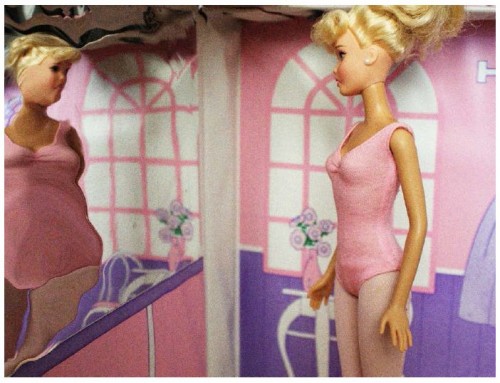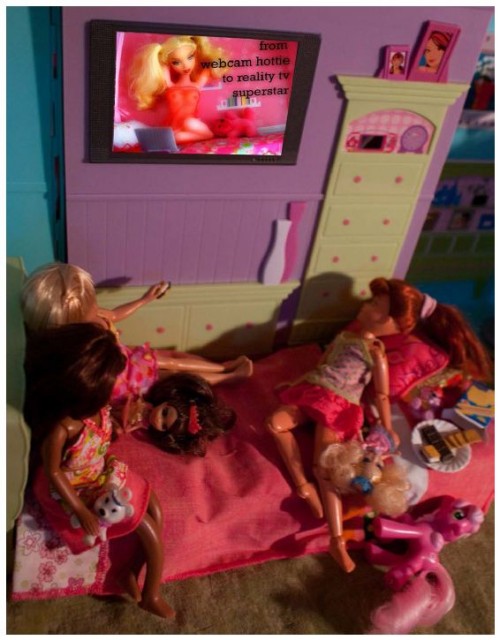Earlier this year, Barbie posed for Sports Illustrated, triggering a round of eye-rolling and exasperation among those who care about the self-esteem and overall mental health of girls and women.
Barbie replied with the hashtag #unapologetic, arguing in an — I’m gonna guess, ghostwritten — essay that posing in the notoriously sexist swimsuit issue was her way of proving that girls could do anything they wanted to do. It was a bizarre appropriation of feminist logic alongside a skewering of a feminist strawwoman that went something along the lines of “don’t hate me ’cause I’m beautiful.”
Barbie is so often condemned as the problem and Mattel, perhaps tired of playing her endless defender, finally just went with: “How dare you judge her.” It was a bold and bizarre marketing move. The company had her embrace her villain persona, while simultaneously shaming the feminists who judged her. It gave us all a little bit of whiplash and I thought it quite obnoxious.
But then I came across Tiffany Gholar’s new illustrated book, The Doll Project. Gholar’s work suggests that perhaps we’ve been too quick to portray Barbie as simply a source of young women’s self-esteem issues and disordered eating. We imagine, after all, that she gleefully flaunts her physical perfection in the face of us lesser women. In this way, Mattel may be onto something; it isn’t just her appearance, but her seemingly endless confidence and, yes, failure to apologize, that sets us off.
But, maybe we’re wrong about Barbie?
What if Barbie is just as insecure as the rest of us? This is the possibility explored in The Doll Project. Using a mini diet book and scale actually sold by Mattel in the 1960s, Gholar re-imagines fashion dolls as victims of the media imperative to be thin. What if Barbie is a victim, too?
Excerpted with permission:




 Forgive me for joining Mattel and Gholar in personifying this doll, but I enjoyed thinking through this reimagining of Barbie. It reminded me that even those among us who are privileged to be able to conform to conventions of attractiveness are often suffering. Sometimes even the most “perfect” of us look in the mirror and see nothing but imperfection. We’re all in this together.
Forgive me for joining Mattel and Gholar in personifying this doll, but I enjoyed thinking through this reimagining of Barbie. It reminded me that even those among us who are privileged to be able to conform to conventions of attractiveness are often suffering. Sometimes even the most “perfect” of us look in the mirror and see nothing but imperfection. We’re all in this together.
Cross-posted at Pacific Standard and Adios Barbie.
Lisa Wade, PhD is an Associate Professor at Tulane University. She is the author of American Hookup, a book about college sexual culture; a textbook about gender; and a forthcoming introductory text: Terrible Magnificent Sociology. You can follow her on Twitter and Instagram.
Comments 34
Bill R — June 17, 2014
A young child is confronted with so much stimuli in this world it is a waste of time to assess each one and criticize what may or may not be negatively influential IF THE CHILD IS LEFT ALONE TO FORM HER OWN PERCEPTIONS OF IT. Better to engage the individual child directly and talk her through her interpretations of these stimuli during the course of daily life (aka parenting).
Put the Barbie bashing to bed already...please...
Kali — June 17, 2014
Barbie may be a victim or a villain, both or either, but she is not a hero. That is the problem. She has extremely mundane and useless interests. If (some) little girls imbue her with anything interesting, it is despite her inherent personality, not because of it.
AlsnB — June 17, 2014
Love the pictures, rolling my eyes a bit at the framing (and more at the "Barbie" essay.) Anthropomorphizing fictional characters to deflect criticism always brings to mind the "You Made Sue Storm Cry!" ridiculousness.
Anna — June 17, 2014
I would hope that the majority of people who care about the self esteem and overall mental health of girls roll their eyes in exasperation at the people who actually believe Barbie has a negative effect on these. The only evidence for it is paper-thin, and has yet to be replicated on a level that would make it credible social science. Not to mention that the hypothesis blindly ignores art history, and diverse historical and anthropological lessons of toys and play, in particular playing with dolls. A manufactured problem if there ever was one.
Amy Santee — June 17, 2014
Great post - it made me stop and think for a moment about the assumptions we all make about other people in our social interactions. Think Goffman's Presentation of Self. We select versions of ourselves to portray to others depending on context, power, and other variables. When you interact with someone, what you can actually see with your eyes isn't the only thing to know about that person; how someone "seems" to be isn't always how he or she actually "is" or "feels." Instead of using Barbie as an example, let's think about the real women (or even men) in our lives who "seem" perfect, "seem" totally confident, "seem" happy and fulfilled, and who "seem" to have it all. It's just not true, even though it can feel that way. It's important to take a step back and remind ourselves that likely everyone on the planet has some insecurity, whether it can be seen visually by others or not. If Barbie were real, maybe she would have all kinds of other insecurities about herself. Our personal issues, insecurity among them, can manifest themselves in so many forms - not just physically.
Lovely Links: 6/20/14 - Already Pretty | Where style meets body image — June 20, 2014
[…] This one made my head spin: Reimagining Barbie: Villain or Victim? […]
Reimagining Barbie: Villain or Victim? | Adios Barbie — September 22, 2014
[…] posted at Sociological Images; cross-posted with […]
TalkToFoodLion survey — April 7, 2025
This article cleverly explores the complex cultural perception of Barbie, highlighting how she has become a lightning rod for debates on feminism and self-esteem. While Mattel's provocative marketing approach with Barbie's unapologetic persona invites criticism, Tiffany Gholar’s *The Doll Project* offers a thought-provoking reimagining. It challenges the narrative by portraying Barbie not as the perpetuator of unrealistic ideals, but as a possible victim of them, sparking reflection on societal beauty standards and their impact. It’s an insightful take on a divisive icon.
Hazel Brown — April 7, 2025
This article cleverly explores the complex cultural perception of Barbie, highlighting how she has become a lightning rod for debates on feminism and self-esteem. While Mattel's provocative marketing approach with Barbie's unapologetic persona invites criticism, Tiffany Gholar’s The Doll Project offers a thought-provoking reimagining. It challenges the narrative by portraying Barbie not as the perpetuator of unrealistic ideals, but as a possible victim of them, sparking reflection on societal beauty standards and their impact TalkToFoodLion survey
Sophia — June 18, 2025
This article made me rethink the image of Barbie – perhaps she is not only a harmful symbol Pokémon Gamma Emerald but also a victim of the unrealistic standards that society imposes on women.
Easyfacto — November 25, 2025
Véritable service intégré à la Banque Delubac & Cie, Delubac factor propose une solution globale d'affacturage adaptée aux besoins spécifiques des TPE et PME.